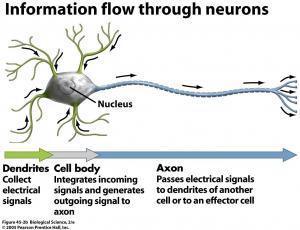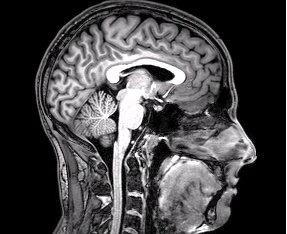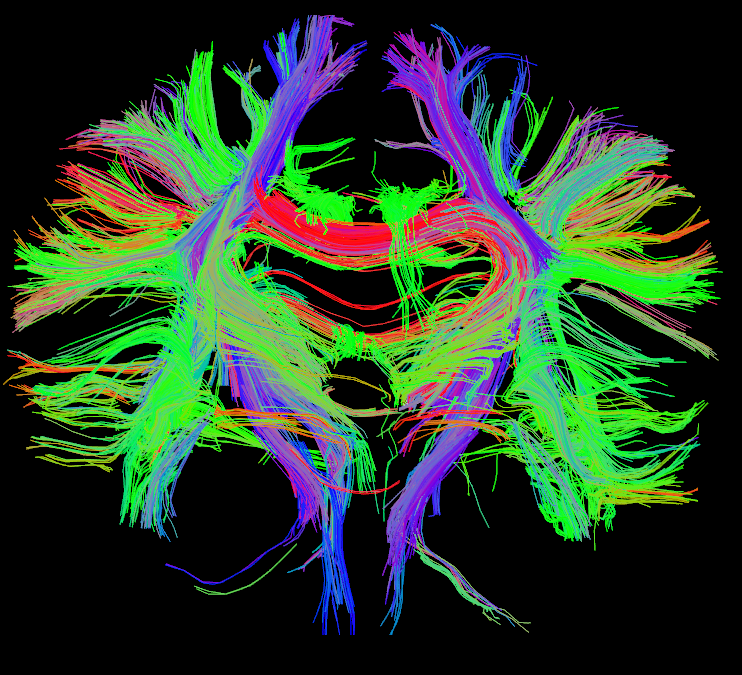I have something beautiful to show you today. And it’s a helpful metaphor for understanding your life as relationship, too.
But first, we need some background on brain structure.
The cells that make up your brain
Brain tissue includes both neurons and glia. Neurons are the cells responsible for communication, while glia support their growth and function. Neurons transmit information through extensions of their membrane, called axons. Just like telephone wires, these axons carry electrical signals from one cell to the other.

Axons are long, thin projections that can be up to three feet long (in humans)! In order for the signal to be carried more quickly, axons are often wrapped in myelin. This fatty insulation speeds up the transmission of the information from one cell to another.
White matter
Axons pretty thin, but they often travel in bundles of thousands of their neighbors. These bundles are tracts in the brain or nerves when they’re found in the rest of the body. Because fat is white, these bundles make up the white matter of your nervous system.
Axon bundles carry information quickly and efficiently from the brain to the spinal cord, or the spinal cord to your limbs and back. Even within the brain itself, tracts help specific regions communicate with each other. This is why your brain can process information so quickly.
Grey matter
Each axon, of course, comes from a neuronal cell body (see above). In the nervous system, these cell bodies live in groups, or nuclei. When you cut the brain open, nuclei show up as grey because they’re not surrounded by fatty myelin. This the grey matter of your nervous system, and it receives and processes the information carried by axons.
What’s important to note, here, are three points.
- Grey matter depends on the connections formed by white matter in order to grow
- When myelin suffers damage, nuclei degrade. Grey matter depends on the white matter in order to stay alive.
- White matter connections get stronger through use, or die off through disuse. In other words, they are experience-dependent.
We’ll come back to this later.
Imaging grey and white matter
This is confusing, so let me give you a visual. The brain is traditionally imaged with MRI, which shows the structure of your tissues using magnetic fields and radio waves.
Below, you see the sagittal (or median) plane of the brain. As you can see, the brain stem and spinal cord are white, because they are full of axon bundles that carry information to and from the brain.

However, there are also ways to image just the white matter in your brain. For instance, Diffusor Tensor Imaging (DTI) uses the rate of water diffusion through the brain to generate spectacular images.

In this image, you see the axons that connect the left and right hemisphere (red), as well as the ones that go down to the brainstem (blue), and out into the cortex (green).
A metaphor for life
Not only beautiful, but a powerful metaphor for the fact that our relationships of love are constitutive of your life.
Remember that white matter connections are the axons that are responsible for linking regions of grey matter, often over long distances.
- Just like white matter connections are necessary for grey matter to develop, we grow and flourish primarily through relationships with others.
- Just like white matter degradation causes the death of grey matter, broken relationships can lead to desolation of the soul.
- Just as white matter gets stronger through use, your relationships grow through active communication, quality time, and shared experience (convivenza, as Giussani calls it).
The human person is made for relationship
Keep this in mind as you navigate the balance between friends and work, family and studies, community and independence. Don’t let your desire for success or productivity lead you away from relationship, or your desire to be safe and secure keep you from encounter.
Building relationships is hard work. It demands humility, patience, and a radical vulnerability in front of the other person. As C.S. Lewis writes:
To love at all is to be vulnerable. Love anything and your heart will be wrung and possibly broken. If you want to make sure of keeping it intact you must give it to no one, not even an animal. Wrap it carefully round with hobbies and little luxuries; avoid all entanglements. Lock it up safe in the casket or coffin of your selfishness. But in that casket, safe, dark, motionless, airless, it will change. It will not be broken; it will become unbreakable, impenetrable, irredeemable. To love is to be vulnerable.
But love is constitutive of our lives. It is through entering into relationships with others that we become human, that we are free to be who we are.
Further reading recommendations
For more on white matter imaging, here is a great review of DTI.
C.S. Lewis’ The Four Loves is a wise and personal exploration of the love that constitutes our lives.
Read Jean Vanier’s Community and Growth, a guide to life in relationship. I can’t recommend it enough.
















